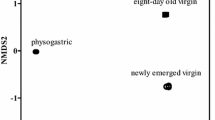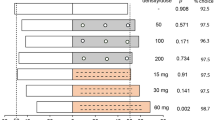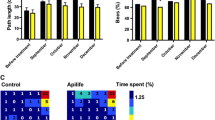Abstract
The ectoparasitic miteVarroa jacobsoni invades worker brood cells of the honeybeeApis mellifera during the last 20 hr before the cells are sealed with a wax cap. Cuticle extracts of 8-day-old worker honeybee larvae occupying such brood cells have an arrestment effect on the mite. The mites run for prolonged periods on the extract, systematically returning onto the stimulus after touching the borders of the treated area. Mites increase walking speed and path straightness in response to increasing doses of a nonpolar fraction of the cuticle extract. Saturated straight-chain odd-numbered C19–C29 hydrocarbons were identified by thin-layer argentation chromatography and gas chromatography-mass spectrometry as the most active constituents, with branched alkanes also contributing to the arrestment effect of this active fraction. Analysis of the behavior responses to syntheticn-alkanes indicate that the response is probably based on a synergism between the different alkane components of the fraction rather than to an individual compound.
Similar content being viewed by others
References
Aitzetmüller, K., andGuaraldo Goncalves, L.A. 1990. Dynamic impregnation of silica stationary phases for the argentation chromatography of lipids.J. Chromatogr. 519:349–358.
Blomquist, G.J., Chu, A.J., andRemaley, S. 1980. Biosynthesis of wax in the honeybee,Apis mellifera.Insect Biochem. 10:313–321.
Boot, W.J., Calis, J.N.M., andBeetsma, J. 1992. Differential periods ofVarroa mite invasion into worker and drone cells of honeybees.Exp. Appl. Acarol. 16:295–301.
Breed, M.D., andStiller, T.M. 1992. Honeybee,Apis mellifera, nestmate discrimination: Hydrocarbon effects and the evolutionary implications of comb choice.Anim. Behav. 43:875–883.
Büchler, R., Drescher, W., andTornier, I. 1992. Grooming behavior ofApis cerana, Apis mellifera andApis dorsata and its effect on the parasitic mitesVarroa jacobsoni andTropilaelaps clarae.Exp. Appl. Acarol. 16:313–319.
Donzé, G., andGuerin, P.M. 1994. Behavioral attributes and parental care ofVarroa mites parasitizing Honeybee Brood.Behav. Ecol. Sociobiol. 34:305–319.
Francis, B.R., Blanton, W.E., Littlefield, J.L., andNunamaker, R.A. 1989. Hydrocarbons of the cuticle and hemolymph of the adult honeybee (Hymenoptera: Apidae).Ann. Entomol. Soc. Am. 82:486–494.
Getz, W. M., andSmith, K.B. 1987. Olfactory sensitivity and discrimination of mixtures in the honeybeeApis mellifera.J. Comp. Physiol. 160:239–245.
Getz, W.M., Brückner, D., andSmith, K.B. 1989. Ontogeny of cuticular chemosensory cues in worker honeybeesApis mellifera.Apidologie 20:105–113.
Grenier, S., Veith, V., andRenou, M. 1993. Some factors stimulating oviposition by the oophagous parasitoidTrichogramma brassicae Bezd. (Hym., Trichogrammatidae) in artificial host eggs.J. Appl. Entomol. 115:66–76.
LeConte, Y., Arnold, G., Trouiller, J., Masson, C., Chappe, B., andOurisson, G. 1989. Attraction of the parasitic miteVarroa to the drone larvae of honeybees by simple aliphatic esters.Science 245:638–639.
LeConte, Y., Arnold, G., Trouiller, J. andMasson, C. 1990. Identification of a brood pheromone in honeybees.Naturwissenschaften 77:334–336.
Liu, T.P. 1990. Palpal tarsal sensilla of the female mite,Varroa jacobsoni Oud.Can. Entomol. 122:295–300.
McDaniel, C.A., Howard, R.W., Blomquist, G.J., andCollins, A.M. 1984. Hydrocarbons of the cuticle, sting apparatus and sting shaft ofApis mellifera L. Identification and preliminary evaluation as chemotaxonomic characters.Sociobiology 8:287–298.
McGill, R., Tukey, J.W., andLarsen, W.A. 1978. Variations of box plots.Am. Stat. 32:12–16.
Milani, N., andNannelli, R. 1988. The tarsal sense organ inVarroa jacobsoni, pp. 71–82,in R. Cavalloro (ed.). Present Status of Varroatosis in Europe and Progress in theVarroa Mite Control. Office for official publications of European Communities, Luxembourg.
Moritz, R.F.A., Kirchner, W.H., andCrewe, R.M. 1991. Chemical camouflage of the death's head hawkmoth (Acherontia atropos L.) in honeybee colonies.Naturwissenschaften 7:178–182.
Nation, J.L., Sanford, M.T., andMilne, K. 1992. Cuticular hydrocarbons fromVarroa jacobsoni.Exp. Appl. Acarol. 16:331–344.
O'Connor, J.G., Burrow, F.H., andNorris, M.S. 1962. Determination of normal paraffins in C20 to C32 paraffin waxes by molecular sieve adsorbtion.Anal. Chem. 34:82–85.
Peng, Y.S., Fang, Y., Xu, S. andGe, L.J. 1987. The resistance mechanism of the Asian honeybee.Apis cerana Fabr., to an ectoparasitic mite,Varroa jacobsoni Oud.J. Invert. Pathol. 49:54–60.
Phelan, P.L., Smith, A.W., andNeedham, G.R. 1991. Mediation of host selection by cuticular hydrocarbons in the honeybee tracheal miteAcarpis woodii (Rennie).J. Chem. Ecol. 17:463–473.
Ramm, D., andBöckeler, W. 1989. Ultrastrukturelle Darstellungen der Sensillen in der Vordertarsengrube vonVarroa jacobsoni.Zool. Jahrb. Anat. 119:221–236.
Rickli, M., Guerin, P.M., andDiehl, P.A. 1992. Palmitic acid released from honeybee worker larvae attracts the parasitic miteVarroa jacobsoni on a servosphere.Naturwissenschaften 79:320–322.
Royalty, R.N., Phelan, L.R., andHall, F.R. 1993. Quantitative and temporal analysis of effects of twospotted spider mite (Acari: Tetranychidae) female sex pheromone on male guarding behavior.J. Chem. Ecol. 19:211–223.
Sato, M., Kuwahara, Y., Mastuyama, S., andSuzuki, T. 1993. Male and female sex pheromones produced byAcarus immobilis Griffiths (Acaridae: Acarina).Naturwissenschaften 80:34–36.
Schmitt, U., Lübke, G., andFrancke, W. 1991. Tarsal secretion marks food sources in bumblebees (Hymenoptera: Apidae).Chemoecology 2:35–40.
Singer, T.L., andEspelie, K.E. 1992. Social wasps use nestpaper hydrocarbons for nestmate recognition.Anim. Behav. 44:63–68.
Tulloch, A.P. 1980. Beeswax—composition and analysis.Beeworld 61:47–62.
Thrasyvoulou, A.T., andBenton, A.W. 1982. Rates of growth of honeybee larvae.J. Apic. Res. 21:189–192.
Waage, J.K. 1978. Arrestment response of the parasitoid,Nemeritis canescens, to a contact chemical produced by its host,Plodia interpunctella.Physiol. Entomol. 3:135–146.
Winston, M.L. 1987. The Biology of the Honeybee. Harvard University Press, Cambridge, Massachusetts.
Author information
Authors and Affiliations
Rights and permissions
About this article
Cite this article
Rickli, M., Diehl, P.A. & Guerin, P.M. Cuticle alkanes of honeybee larvae mediate arrestment of bee parasiteVarroa jacobsoni . J Chem Ecol 20, 2437–2453 (1994). https://doi.org/10.1007/BF02033212
Received:
Accepted:
Issue Date:
DOI: https://doi.org/10.1007/BF02033212




